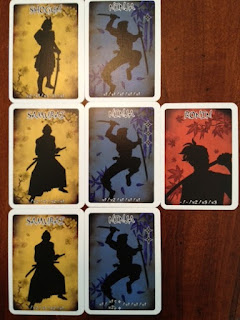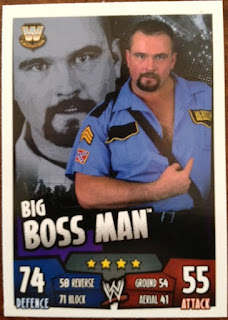I love Bang! My wife loves Bang! even more. So, when I heard that a re-themed game was coming out in the Bang! system - but without player elimination, I immediately put it on my want list. And, that game is Samurai Sword (sorry, I couldn't find an Amazon link).
In Samurai Sword, each player is given a character (which has special abilities) and a "role." Based on which role card you receive, you will be on a team with other players. However, you do not know who is on that team with you, as the roles are all kept hidden - with the exception of the Shogun, who reveals his role to everyone. Once this is completed, each player starts with a certain number of "honor points" - and the Shogun (as the easy target) starts with one extra. On each turn, you have the option of playing as many cards as you want, but only one weapon card per turn. And, if you successfully remove a player's last "resilience point" (life point), then you take an honor point from them, and they are "harmless" until their next turn, when they will restore their resilience points. (Harmless means they cannot be attacked and are immune to the various "attack everyone" cards. You can also be harmless if you do not have any cards in your hand.) Once one player runs out of honor points, the game is over. (And, to speed this up, each time that the draw deck is exhausted, everyone loses an honor point.) Once the game is over, everyone reveals their role and counts points. Based on your role, your points might be worth more than one point each, and whichever team has the most points at the end of the game wins!
Now that I've given you the summary, I'm going to really start comparing this game to Bang! If you're not familiar with it, then I'd recommend that you check out my review of Bang! (And, while there, you might notice that I gave it an 8, and at the top of this post, I said I love Bang! I haven't decided if I just gave it too low of a score to start with, or if it has grown on me a lot since then. Oh well.) I assume that you will want one of these games - after all, I did say that I love Bang! (which means you should too), and so this comparison will hopefully help you decide which one.
 |
| New roles |
Another aspect of the lack of player elimination (and the score being calculated based on points) is that it is suddenly much more important to try to figure out who is on your team. In Bang!, there is a good chance that I will kill an Outlaw, even if I am an Outlaw, as it allowed me to draw more cards. However, in Samurai Sword, you really want to make sure that you are working together with your other teammates (if you have any) to gain as many points as you can. And, an interesting element of this that I discovered, is that it might occasionally be good to kill off your teammate (or let them kill you off) if they are running low on health - after all, it is better for you to steal an honor point from them than for one of the the other teams to steal it!
The third effect that I noticed of changing to the scoring system instead of the player elimination strategy is that the "Ronin" role (the player on a team by himself, similar to the Renegade in Bang!) is suddenly feasible. I have played a lot of games of Bang!, and I very rarely see the Renegade win. He is a crucial part of the game, to keep the Sheriff's team from getting slaughtered, but it is definitely the least victorious role. However, if you draw the Ronin in Samurai Sword, you actually have a very strong chance of victory. Why? Because your points are all multiplied at the end of the game to compensate for you not having teammates. In a 6-player game, all of your honor points are worth three victory points each! So, the game feels a lot more balanced as the Ronin - you're not necessarily going to get an easy victory, especially if the other players figure out who you are, but you definitely stand a better chance of victory than before.
 |
| Weapon cards - showing difficulty and damage |
The last thing that I will mention about Samurai Sword is that weapon and attack cards have been combined into "weapon cards." And, some weapon cards are able to do more than one damage (which I believe is another aspect of not having player elimination - after all, you don't want to be hit for three damage, if that is going to kill you and make you sit out). You still calculate distance (or now, "difficulty") by counting how many players are between you and the player that you wish to attack, and now you must play a weapon card that has that high of a difficulty rating. I actually liked this tweak to the attack system, as you don't run into situations where you have a lot of amazing weapons, but no ammunition (Bang! cards) to go with them. And yet, they were able to keep the aspect of the game that it is always easiest to attack the players next to you - thus causing confusion about who is on each team.
Overall, I give Samurai Sword an 8.5/10. I really enjoyed the game, and I will probably play it more. When deciding between Samurai Sword and Bang!, I think that the main decision is whether you like player elimination. If you do, then you should play Bang!; if not, then you should play Samurai Sword (or, as I call it, "Japan Bang!").
If Samurai Sword sounds fun, then you might also want to check out Lunch Money, The Resistance, and Poo: The Card Game
I would like to thank dv Giochi for providing me with a review copy of Samurai Sword.






















